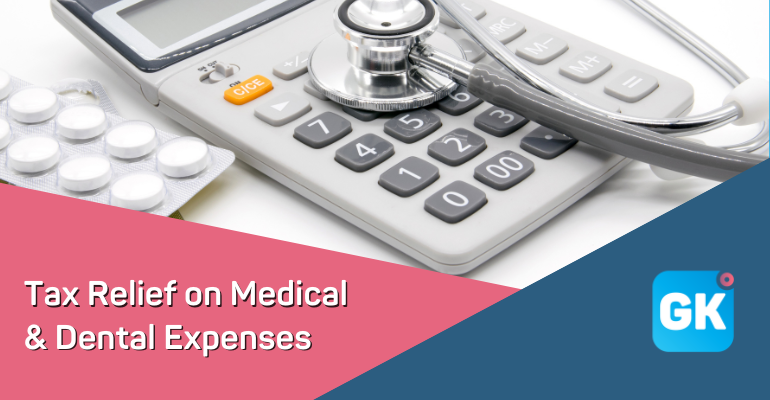Tax Relief on Medical & Dental Expenses

Medical and dental work can be expensive, so it’s a good thing that many treatments qualify for tax relief allowing you to deduct a proportion of their cost from your annual tax liability. You can claim relief on the cost of health expenses. These can be your own health expenses, those of a family member or any individual’s, as long as you paid for them. It’s important to note that only expenses that are not covered by private health insurance or any other third-party reimbursement can be claimed for tax relief. However, if the insurance coverage is partial, the remaining out-of-pocket expenses can still qualify for tax relief.
Here are some examples of qualifying health expenses that are paid for:
- Doctor’s and consultant’s services
- Routine and maternity care for women during pregnancy
- Diagnostic procedures recommended by a practitioner
- Services in hospitals or treatment facilities such as clinics, where the services are either:
- provided by a practitioner
- or
- diagnostic procedures recommended by a practitioner
- Transport by ambulance
- In-vitro fertilisation (IVF)
- Acupuncture (only where provided by a practitioner)
- Non-routine dental care
- Treatment from a psychologist or psychotherapist where either:
- the psychologist or psychotherapist is a practitioner
- or
- you are referred for a diagnostic procedure by a practitioner
- Additional expenses of health care for a child:
- suffering from a life-threatening illness or permanent disability
- or
- who needs speech and language therapy or educational psychological assessment
- Additional expenses for a kidney patient
- Nursing home and additional nursing care expenses.
You can also claim relief on the following if you are prescribed, referred or advised to, by a practitioner:
- Drugs and medicines
- Orthoptic or similar treatment (treatment for squints and eye movement disorders)
- Physiotherapy or similar treatment (such as a chiropractor, osteopath or bone setter)
- Podiatry or chiropody costs.
- Special diet expenses for coeliacs and diabetics
- Cost of purchasing, maintaining and repairing medical, surgical, dental or nursing appliances.
You can’t claim relief on:
- Routine dental care
- Routine ophthalmic (eye) care, such as eye tests
- Cosmetic surgery or procedures, such as rhinoplasty, breast augmentation or Botox treatment
(Relief may be available where the surgery corrects a health issue, such as breathing difficulties. )
Can you claim for health care received outside Ireland?
Yes. To qualify for relief, the medical practitioner must be registered under that country’s laws to practice medicine or dentistry there. If you travel abroad to receive health care that is not available in Ireland, you can also claim relief on:
- Reasonable accommodation and travel costs
- The accommodation and travel costs of a person who accompanies you (if your condition requires it).
Dental expenses:
Any treatments that fall under the category of routine care do not qualify for dental tax refunds. This includes:
- Fillings
- Scaling or cleaning
- Tooth extraction
- Providing or repairing artificial teeth or dentures.
Non-routine dental treatments:
You can claim relief for non-routine dental care. This includes:
- Crowns
- Veneers or Rembrandt-type etched fillings
- Tip replacing
- Gold posts or fibreglass posts
- Inlays (a smaller version of a gold crown). (You can only claim relief for gold if they are made outside the mouth.)
- Endodontics (root canal treatment)
- Periodontal treatment for gum disease such as:
- root planing (including curettage and debridement) and gum flaps
- chrome cobalt splints (but not if it contains teeth)
- implants (including bone grafting and bone augmentation)
- Orthodontic treatment (provision of braces and related treatments)
- Surgical extraction of impacted wisdom teeth
- Bridgework (an enamel-retained bridge or a tooth-supported bridge).
Non-routine dental care outside Ireland:
You can claim for non-routine dental treatment performed outside of Ireland. To qualify for relief, the dentist must be a qualified dentistry practitioner under that country’s laws. You must have the dentist complete Form Med 2 for your claim.
How much tax relief will I get?
The amount of tax relief that can be claimed depends on the individual’s marginal tax rate. Currently, the relief is granted at a rate of 20% for most taxpayers. However, individuals with higher incomes may be eligible for a higher rate of relief, up to 40%.
It’s worth noting that tax relief on medical and dental expenses operates on a cumulative basis. This means that if the total qualifying expenses for a particular year do not exceed a certain threshold, no relief is granted. However, if the expenses exceed the threshold, the taxpayer can claim relief on the excess amount.
To claim tax relief on medical and dental expenses, individuals must keep detailed records of their healthcare expenses throughout the tax year. This includes receipts, invoices, and statements from healthcare providers. It is advisable to keep a dedicated folder or digital file to organize and store all relevant documentation.
Taxpayers can claim relief for their own expenses, as well as for their dependents, such as children or elderly family members under their care. The relief is available regardless of whether the taxpayer is employed, self-employed, or retired.
Get in Touch:
If you need a reliable professional accountant to look after your medical and dental expenses, why not call us now?
Please call us on (01) 969 5100


